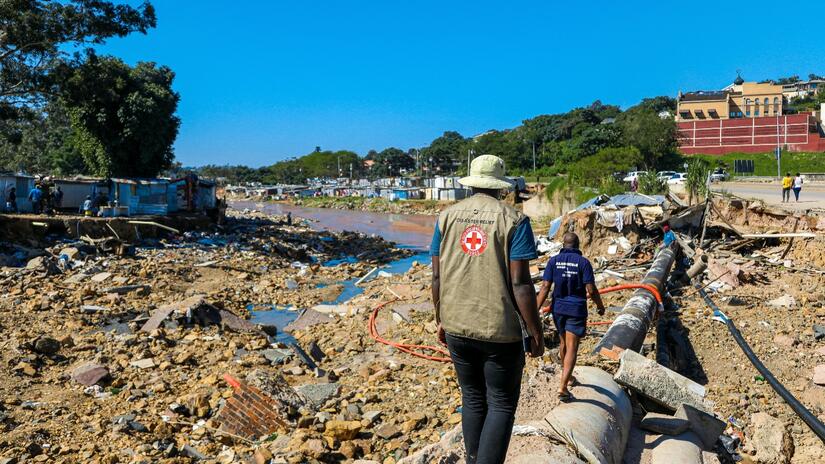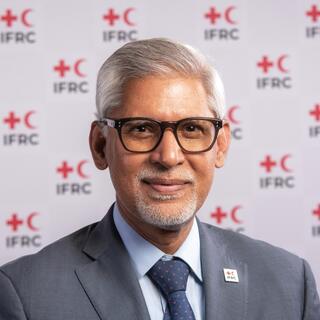I am honoured to submit this Official Statement on behalf of the International Federation of Red Cross and Red Crescent Societies (IFRC).
The GP2022 theme, “From Risk to Resilience: Towards Sustainable Development for All in a COVID-19 Transformed World” could not be more relevant to us as we face growing needs and an uncertain future.
COVID-19 has already taken more than 6.2 million lives and has increased vulnerabilities worldwide, particularly among women, children, elders, and persons with disabilities.
At the same time, more people are under threat from the climate crisis, conflict, disaster, and disease. The humanitarian needs of 2022 will be, at least, double what they were in 2019.
Today we are at a critical juncture. Not only must we recover fully from this pandemic, but we must also review our readiness and change our modus operandi to proactively deal with future risks. We must move from responding to crises, to building individual and community capacities to anticipate, prepare for, reduce the impact, cope with and recover from crises. This must be done without compromising their long-term prospects, in other words, strengthening their resilience to future risks.
To achieve this, IFRC calls for collective action in the following areas:
First, we must inspire community action that revolutionises positive change.
Communities have agency, self-reliance and their own hopes and plans for the future. Our efforts will only benefit them if we centre their priorities, experiences and expertise, and support their actions. We have to support communities to come together to tackle the challenges that they are currently facing, and prepare for those that lie ahead.
Funding and partnerships need to support individuals and communities to understand their risks, take action to address them, and participate in official decision-making processes.
Local actors such as National Red Cross and Red Crescent Societies are critical to informing and channeling investments to the right places, to those most in need, where scarce resources can have the greatest impact. They need to be in the driver’s seat of change, and this includes women and youth.
Second, trust the science.
We must listen to the science and use it to plan for and protect against future risks. Extreme climate and weather events are becoming more frequent and more intense, affecting new places with many hazards striking at the same time.
We can’t use what happened in the past to predict the future. We have to trust and act upon the science. This must be our standard way of working. Anticipatory action that puts communities at the centre must be the new normal if we want to reduce humanitarian needs, avert loss and damage caused by climate change.
Third, leverage the power of partnerships.
We can only become more resilient if we collaborate together but this means working more broadly than the humanitarian, development and climate sectors. We must also look to the private and public sectors, local governments, grassroots communities and further – we are trying to overcome the same challenges but with different means. How can the private sector engage in ways that drive social impact? How can governments lead change with enabling frameworks? How do humanitarian agencies embrace agility in their business models?
Together with our partners, we have taken various initiatives, including the Anticipatory Action Task Force, Forecast-based Action by the Disaster Response Emergency Fund (DREF), the Anticipation Hub, the Country Support Platform of the Global Taskforce for Cholera Control, and the Risk-informed Early Action Partnership (REAP), which we call on our partners to join.
Fourth, we must change the way we do business.
People-centred partnerships towards achieving the SDGs will require new approaches to programming and donor funding. These must allow the private sector to meaningfully engage and demonstrate the value of structures that can be more sustainable, replicable, and scalable to address growing humanitarian and development needs.
Developing countries will need more than USD 2.5 trillion a year to fill the SDG financing gap, but there is only some USD 150 billion of total overseas development assistance available. However, private capital sources alone amount to more than USD 200 trillion. We need to consider smart financing that helps donated resources reach further, by creating multiplier opportunities.
At all times, communities must be at the heart of decisions made in investment and programming for inclusive disaster risk reduction, epidemic and pandemic preparedness, and climate change adaptation. The communities most vulnerable to disasters, as well as fragile and conflict affected settings and those displaced or at risk of displacement, must be prioritized.
Governments can assist by ensuring that national disaster and climate laws, policies, financial instruments, and plans all include a focus on reducing risks for the most vulnerable people.
In responding to the COVID-19 pandemic, IFRC and National Red Cross and Red Crescent Societies have made good use of the preparedness capacity built over the years. From the outset, we have met the growing health needs and demands of vulnerable communities, building on local solutions and leveraging National Red Cross and Red Crescent Societies’ role as independent auxiliaries to their governments in the humanitarian arena.
In the past two years, the IFRC network supported nearly 1.2 billion people through our COVID-19 programmes. This support has included risk communication, community engagement activities for health and hygiene promotion, water and sanitation, and food and cash assistance. And beyond our emergency response, our National Societies reached 139 million people through pandemic-proof disaster risk reduction programming, using the IFRC’s guide for “Climate-smart disaster risk management programming during the COVID-19 pandemic”.
Rest assured we will continue our efforts to create a culture of prevention and resilience by mobilizing our global network of 192 National Societies, 160,000 local branches and 14.9 million community-based volunteers.
I take this opportunity to pay tribute to the Indonesian Government and the Indonesian Red Cross for their great efforts to protect people and their livelihoods from disasters and crises.
Thank you, and I wish you a successful Global Platform.


